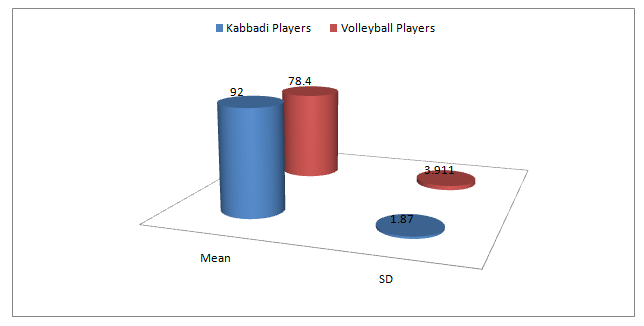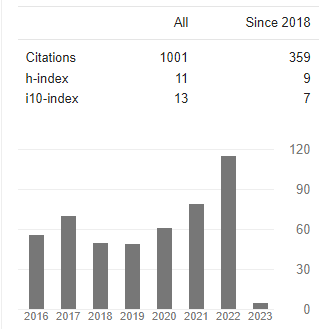ANALYSIS OF POLYSOMNOGRAPHY VARIABLES ON MALE SPORTS PERSONS IN RESPONSE TO YOGA NIDRA
Abstract
The purpose of this study was to compare polysomnography variables on male sports persons. The subjects for the present study were consisting of Ten (N=10), Male Sports persons i.e., Kabbadi and Volleyball Players of Punjabi university, Patiala, Punjab. After preparing the list of subject’s age ranged from 21-25 years, the investigator checked the health record of these subjects maintained by the health department of the university to ensure that the subjects were medically fit to undergo the different types of tests. The selection of the appropriate polysomnography variables between male sports persons the researcher had chosen the factors for the investigation in Response to Yoga Nidra i.e., time in bed, sleeps time, sleep efficiency, sleep onset latency, rapid eye movement.The Statistical Package for the Social Sciences (SPSS) version 21 was used for all analyses. The differences in the mean of each group i.e. Sports persons (Kabbadi and Volleyball Players) for selected polysomnography variable were tested for the significance of difference by applying paired samples „t‟ test. For testing the hypotheses, the level of significance was set at 0.05 percent (p<0.5).To conclude, it is significant to mention in relation to Time in Bed that results of Analysis of Variance (ANOVA) among Male Sports Persons i.e., Kabbadi and Volleyball Players (N=10) were found statistically insignificant (P> .05). Furthermore, in relation to Total Sleep Time, Sleep Efficiency, Sleep Onset Latency, Rapid Eye Movement that result of Analysis of Variance (ANOVA) among Male Sports Persons i.e., Kabbadi and Volleyball Players (N=10) was found statistically significant (P< .05).
Downloads
References
Archer, S. N., & Oster, H. (2015). How sleep and wakefulness influence circadian rhythmicity: effects of insufficient and mistimed sleep on the animal and human transcriptome. Journal of sleep research, 24(5), 476-493.
Aschoff, J. (1967). Human circadian rhythms in activity, body temperature and other functions. Life sciences and space research, 5, 159-173.
Black, D. S., Milam, J., &Sussman, S. (2009). Sitting-meditation interventions among youth: A review of treatment efficacy. Pediatrics, 124(3), e532-e541.
Caldwell, K., Harrison, M., Adams, M., Quin, R. H., &Greeson, J. (2010). Developing mindfulness in college students through movement-based courses: effects on self-regulatory self-efficacy, mood, stress, and sleep quality. Journal of American College Health, 58(5), 433-442.
Chong, C. S., Tsunaka, M., & Chan, E. P. (2011). Effects of yoga on stress management in healthy adults: a systematic review. Alternative therapies in health and medicine, 17(1), 32.
D’cunha, R., Pappachan, B., D’souza, O. L., Tonse, R., Saldanha, E., &Baliga, M. S. (2021). Effectiveness of yoga nidra in mitigating stress in women undergoing curative radiotherapy for cervical cancer. Middle East Journal of Cancer, 12(1), 117-127.
Singh, M., Kadhim, M.M., Turki Jalil, A. et al. A systematic review of the protective effects of silymarin/silibinin against doxorubicin-induced cardiotoxicity. Cancer Cell Int 23, 88 (2023). https://doi.org/10.1186/s12935-023-02936-4 https://cancerci.biomedcentral.com/articles/10.1186/s12935-023-02936-4
Deckro, G. R., Ballinger, K. M., Hoyt, M., Wilcher, M., Dusek, J., Myers, P., & Benson, H. (2002). The evaluation of a mind/body intervention to reduce psychological distress and perceived stress in college students. Journal of American College Health, 50(6), 281-287.
Hagins, M., Haden, S. C., & Daly, L. A. (2013). A randomized controlled trial on the effects of yoga on stress reactivity in 6th grade students. Evidence-Based Complementary and Alternative Medicine, 2013.
SINGH SIDHU, A., & SINGH, M. (2022). KINEMATICAL ANALYSIS OF HURDLE CLEARANCE TECHNIQUE IN 110M HURDLE RACE. International Journal of Behavioral Social and Movement Sciences, 4(2), 28–35. Retrieved from https://ijobsms.org/index.php/ijobsms/article/view/267
Singh, A., & Singh , D. M. (2013). PROMOTION OF RESEARCH CULTURE –ENHANCING QUALITY IN HIGHER EDUCATION. International Journal of Behavioral Social and Movement Sciences, 2(2), 202–208. Retrieved from https://ijobsms.org/index.php/ijobsms/article/view/152
SINGH, M., & SINGH SIDHU, A. (2016). A COMPARATIVE STUDY OF BODY COMPOSITION AND RELATIVE HEALTH STATUS AMONG RESIDENT AND NON-RESIDENT STUDENTS IN DIFFERENT SCHOOLS OF J&K. International Journal of Behavioral Social and Movement Sciences, 5(3), 08–13. Retrieved from https://ijobsms.org/index.php/ijobsms/article/view/320
Jensen, P. S., Stevens, P. J., & Kenny, D. T. (2012). Respiratory patterns in students enrolled in schools for disruptive behaviour before, during, and after yoga nidra relaxation. Journal of Child and Family Studies, 21(4), 667-681.
Kim, S. D. (2014). Effects of yogic exercises on life stress and blood glucose levels in nursing students. Journal of physical therapy science, 26(12), 2003-2006.
Oman, D., Shapiro, S. L., Thoresen, C. E., Plante, T. G., & Flinders, T. (2008). Meditation lowers stress and supports forgiveness among college students: A randomized controlled trial. Journal of american college health, 56(5), 569-578.
Rani, K., Tiwari, S. C., Kumar, S., Singh, U., Prakash, J., & Srivastava, N. (2016). Psycho-biological changes with add on yoga nidra in patients with menstrual disorders: a randomized clinical trial. Journal of caring sciences, 5(1), 1.
Reid, K. J., & Abbott, S. M. (2015). Jet lag and shift work disorder. Sleep medicine clinics, 10(4), 523-535.

Copyright (c) 2023 Nishan Singh Deol, Amrinder Singh, Savita Rani

This work is licensed under a Creative Commons Attribution 4.0 International License.














